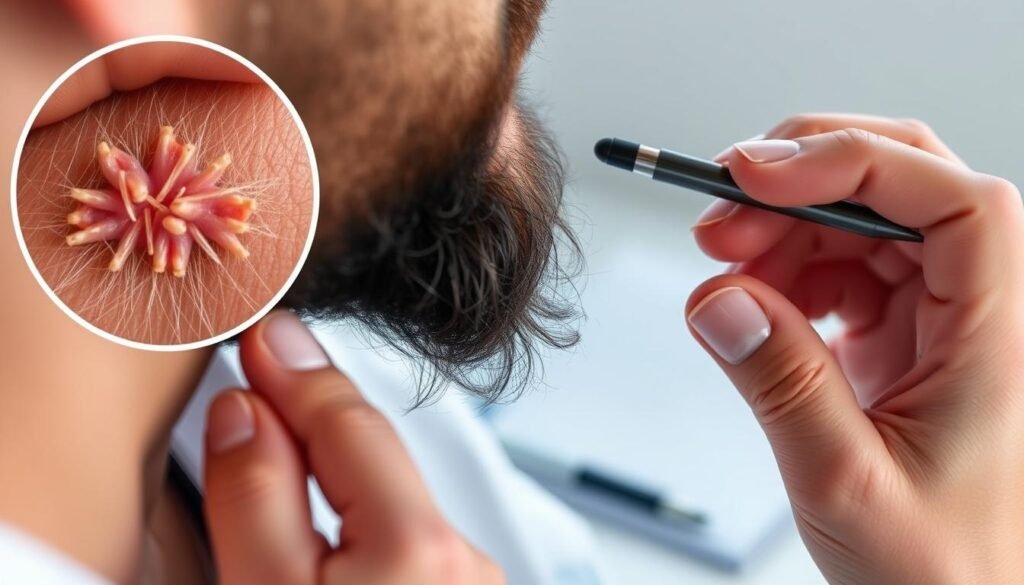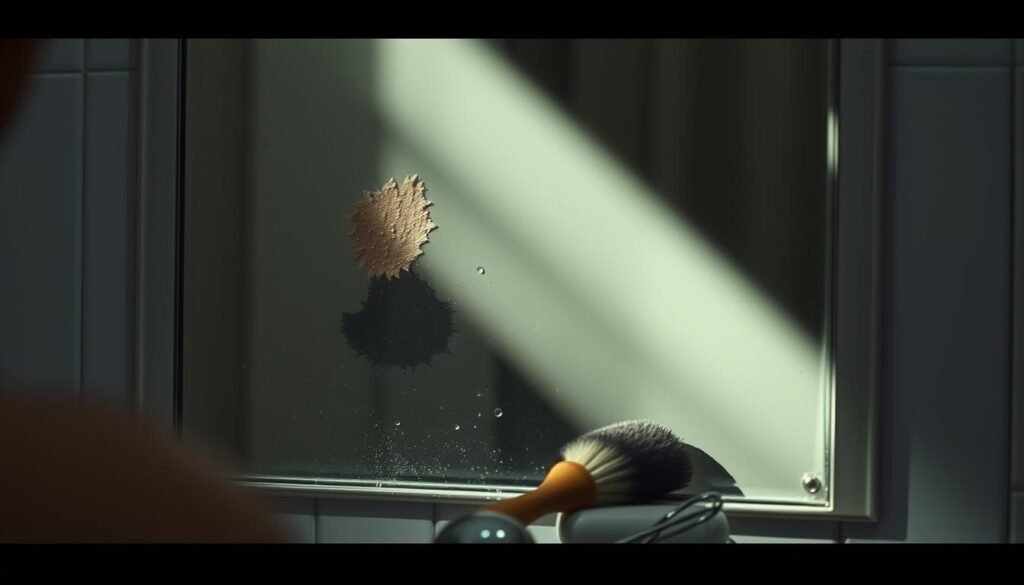Did you know about 30% of people with alopecia areata face alopecia barbae too? This condition focuses on men’s beards, causing patchy bald spots. It happens when the immune system mistakenly attacks hair follicles. If you’re dealing with alopecia barbae, it’s essential to understand it. This knowledge helps in regaining confidence. We will explore what causes it, the symptoms, and how to treat it. This way, affected individuals can get the support they need.
Key Takeaways
- Alopecia barbae, an autoimmune disease, specifically targets facial hair.
- Approximately 30% of individuals with alopecia areata also develop patchy beard hair loss.
- Common treatments include topical corticosteroids and minoxidil to stimulate hair regrowth.
- Regular monitoring and adjustments to treatment are recommended for optimal results.
- Platelet-rich plasma (PRP) therapy is gaining popularity for stimulating hair regrowth.
What is Alopecia Barbae?
Alopecia barbae is a type of hair loss that affects the beard. It’s known for causing beard bald spots. This happens when the immune system mistakenly attacks hair follicles. This leads to losing hair in patches, sometimes in circles. It usually appears on the cheeks, jawline, and neckline.
This condition is a part of alopecia areata, which might get worse over time. If it does, it could lead to alopecia totalis, a more severe hair loss. Studies show that about half the people with beard alopecia might lose hair on other body parts too. However, many see their hair come back naturally within 6 to 12 months.
Most people who get alopecia barbae are men in their middle years. There’s a possibility it runs in families. Research shows between 20% and 42% of cases have a family history. It’s important to learn about this condition since it affects quite a few. For more info, check out this link to alopecia barbae information.
Causes of Alopecia Barbae
Alopecia barbae is a type of hair loss that happens in the beard area. It’s caused by the body attacking its hair follicles by mistake. This is due to autoimmune problems. Autoimmune diseases mess with how our bodies work. People with conditions like type 1 diabetes and lupus are more likely to get alopecia barbae.
Genetics also matter a lot in alopecia barbae. If your family has a history of alopecia or autoimmune diseases, you might be more at risk. Studies show that people usually start seeing symptoms between the ages of 30 and 40. This suggests a strong genetic link.
Stress is another big cause. When people go through tough times emotionally, it can start or make alopecia barbae worse. It’s important to understand how these things work together. This knowledge can help find better ways to deal with alopecia barbae.
| Factor | Description |
|---|---|
| Autoimmune Issues | Body’s immune system attacks hair follicles. |
| Genetics | Inherited predisposition from family history of alopecia or autoimmune diseases. |
| Psychological Stress | Emotional distress and trauma may trigger or worsen hair loss. |
Symptoms of Alopecia Barbae
The symptoms of alopecia barbae are easily noticed. They appear as smooth, round bald spots in the beard area. These bald patches can be big or small. Sometimes they overlap, creating larger bald areas. Often, these spots feel itchy or tingly, which can be annoying.
Hair that falls out may look unusual, called “exclamation mark” hairs. They’re thin at the bottom, near the skin. This sign points to inflammation in the beard’s hair follicles. Unlike other hair loss types, alopecia barbae doesn’t make the skin around it red or painful. This fact helps doctors tell it apart from other skin problems.
- Appearance of smooth, bald patches
- Varied patch sizes that may overlap
- Itchiness or tingling sensations
- Presence of “exclamation mark” hairs
- No significant skin inflammation or pain
If you’re losing beard hair, watching for these signs is key. Spotting the symptoms of alopecia barbae early means you can get help faster. For more on how to treat it and other details, click here.
How to Diagnose Alopecia Barbae
To diagnose alopecia barbae, a skilled dermatologist or trichologist is needed. First, they do a physical inspection of your beard. They check the hair loss patterns. This step is very important to spot alopecia barbae’s unique signs, setting it apart from other hair loss types.
Sometimes, a scalp biopsy might be suggested by the dermatologist. For this, a small skin sample from the beard area is taken for closer examination under a microscope. This biopsy can confirm alopecia barbae and check for other issues like fungal infections or thyroid problems. These thorough checks are vital for the right diagnosis and treatment plan.
In essence, diagnosing alopecia barbae correctly requires detailed checks and sometimes additional tests by experts. This ensures patients get the best, personalized care they need.

Common Treatments for Alopecia Barbae
A variety of treatments exist for alopecia barbae. They aim to reduce symptoms and promote hair growth. Although no cure exists, these methods can effectively manage the condition.
Corticosteroids are commonly used treatments. Intralesional corticosteroids help those with mild alopecia areata, targeting under 25% hair loss. Topical corticosteroids, like lotions and creams, allow precise application. Stronger doses can boost hair regrowth by about 25%.
Minoxidil offers a solution in 2% and 5% topical formulas. It helps regrow hair on the scalp and in beard areas. Some users see a notable improvement, often around 25%. Oral minoxidil has also helped in some cases, though it’s not FDA-approved for this use.
Janus kinase (JAK) inhibitors are emerging treatments. For moderate to severe alopecia, Baricitinib has been FDA-approved. In trials, 32% to 35% of patients saw significant hair regrowth. Contact immunotherapy also has varying success, with regrowth rates between 17% and 75%.
Dermatologists sometimes suggest other medications like prednisone or methotrexate. These help with the immune system and encourage hair growth. Prostaglandin analogs, including bimatoprost, can also promote eyelash growth for those with hair loss.
Managing alopecia barbae well means using a mix of treatments suited to each person. Knowing all options helps in having informed talks with your doctors. This way, you can find a more personalized hair regrowth and symptom management plan.
| Treatment Type | Form | Usage | Expected Improvement |
|---|---|---|---|
| Corticosteroids | Intralesional, Topical | Reduced inflammation, immune suppression | Up to 25% |
| Minoxidil | Topical Solution | Stimulates regrowth | Approx. 25% |
| JAK Inhibitors | Oral | Severe cases | 32% – 35% regrowth |
| Contact Immunotherapy | Topical | Allergic reaction provocation | 17% – 75% regrowth |
Medications for Managing Alopecia Barbae
There are various meds to tackle alopecia barbae. Corticosteroids stand out as a common choice. They lower inflammation and help stop your body from attacking hair roots. Among them, triamcinolone acetonide injections helped 71% of people with a type of alopecia see their hair come back.
Looking for new options? Try JAK inhibitors like ruxolitinib and tofacitinib. They block harmful immune signals and have helped 76% to 90% of patients. This is an exciting progress for those with severe hair loss.
Topical treatments like minoxidil and anthralin are also effective. More than 75% hair came back in 61% of patients using a 0.1% betamethasone valerate foam. Minoxidil worked for 63.6% of users. Using 5% minoxidil and 0.5% anthralin led to good results for about 11% of people. This shows personalize treatment is key.
Making sense of the different medicines for alopecia barbae is crucial. Each option has its own pros and cons. Talking to a healthcare expert can help pick the right method for you.

| Medication | Type | Success Rate |
|---|---|---|
| Corticosteroids (Triamcinolone Acetonide) | Injection | 71% Hair Regrowth in Subtotal Alopecia Areata |
| JAK Inhibitors (Ruxolitinib, Tofacitinib) | Oral | 76-90% Success Rate |
| Topical Corticosteroids | Topical | 61% with 0.1% Betamethasone Valerate |
| Minoxidil | Topical | 63.6% Hair Regrowth |
| Combination Therapy | Topical | 11% Cosmetically Acceptable Regrowth |
Home Remedies for Alopecia Barbae
Alopecia barbae causes patchy hair loss in the beard area. It leads people to try various home remedies for alopecia barbae. While seeing a professional is key, natural remedies can also help. Oils like rosemary and lavender might help scalp health. Yet, how well they work on beard hair is still unclear.
Garlic gel stands out as a natural remedy. A 2007 study showed it could help a lot when used with corticosteroid creams. This points to its value for people with alopecia barbae.
Adding certain foods to your diet and taking biotin supplements may also boost hair growth. Experts often suggest combining supplements such as zinc, vitamin C, and folic acid with biotin. This mix can support better hair health, research shows.
Yet, it’s important to talk to a doctor before trying new remedies. As treatments for alopecia continue to improve, getting advice from reliable sources is a good idea. For deeper insights, check out natural treatments for alopecia areata. Also, explore more on home remedies and their effectiveness.
| Remedy | Description | Efficacy |
|---|---|---|
| Garlic Gel | Natural gel derived from garlic, used topically. | Promising in studies, especially with corticosteroid cream. |
| Essential Oils | Includes rosemary and lavender, used in scalp massages. | Limited research; potential for scalp health. |
| Biotin Supplements | Oral supplements to promote hair growth. | Positive impact when included in a healthy diet. |
| Zinc and Vitamin C | Nutrients that support overall hair health. | Regular supplementation may show benefits. |
The Emotional Impact of Alopecia Barbae
Alopecia barbae affects more than just appearance. It can hit hard on someone’s mental state and how they see themselves. People with this condition often feel self-conscious, worried, or sad. Studies show that many with alopecia barbae have high levels of stress and sadness.
In one study, about two-thirds felt depressed and more than 70% felt anxious. These emotions can lead people to avoid social situations. This affects their daily life and confidence. The average scores for depression and anxiety were around 5. This means most people’s symptoms are mild to moderate.

Having the right mental health support is key to dealing with these feelings. Finding support through online groups or therapy can be very helpful. It provides a place to share and grow stronger. Feeling connected and accepted can lessen the strain of alopecia barbae.
- Join online support groups for shared experiences.
- Seek professional therapy as part of a coping strategy.
- Practice relaxation techniques to manage anxiety.
- Engage in hobbies that boost self-esteem.
It’s crucial to have good ways to cope with the emotional impact of alopecia barbae. Mental health experts can help find strategies that work best for you. Groups like the National Alopecia Areata Foundation offer more help. They provide resources for community support and coping methods.
| Emotional Issue | Prevalence | Severity Score (Median) |
|---|---|---|
| Depression | 66.7% | 5 (IQR 0.0–10.0) |
| Anxiety | 73.3% | 5 (IQR 0.0–11.0) |
| Mild Depression | 82.0% | N/A |
| Moderate Depression | 18.0% | N/A |
| Mild Anxiety | 89.0% | N/A |
| Moderate Anxiety | 11.0% | N/A |
Can Alopecia Barbae Affect Other Facial Hair?
Alopecia barbae mainly affects the beard area, leading to bald spots. But, it can hurt other facial hair loss areas like eyebrows and mustaches. These may start small and then grow, affecting more of the facial hair.
At times, hair loss might happen in many places on the face at once. This fact makes alopecia barbae different from other hair loss types. People need to know that alopecia barbae affects facial hair beyond the beard, spreading to other areas. This spreading can deeply upset those dealing with it.
There’s a chance that alopecia barbae can get worse, turning into alopecia totalis. This results in losing all body hair, including on the face. If you’re losing hair like this, it’s important to get help early to avoid other issues.
By regularly checking on the condition, you can keep track of the alopecia’s progress. There are many ways to treat it, with creams and medicines being common. If you have an autoimmune disorder too, it’s key to think about this in your treatment plan. To learn more about how to treat it, visit this resource.
Conclusion
Alopecia barbae does more than just affect facial hair. It deeply impacts how a person feels about themselves. Knowing about alopecia barbae is the first step in tackling it. It helps to understand the symptoms and find the best way to deal with them. The causes can be genetic or due to stress.
This knowledge lets people take action and try out different solutions. Treatments might include shots of corticosteroids or even newer methods like PRP therapy.
It’s crucial for those dealing with alopecia barbae to get expert advice. They should also connect with others facing the same challenges. Support groups and dermatologist appointments can be very comforting. They offer ways to handle the emotional struggle. Plus, basic things like eating well can help manage the condition.
Even though alopecia barbae is tough, there is a way to deal with it. Learning, getting support, and trying out treatments are key steps. These actions can really improve someone’s life. Looking into treatments like Olumiant for related issues might also help. Check out more on these treatments through this link.